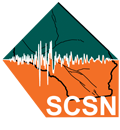Events
- A number of earthquakes with magnitude above 3 have occurred in this cluster of events near Ventura, the largest being M3.6:
- M3.6, 08 Nov 2019 05:29:38 PST, (34.278, -119.287), depth 11.5km, 6km W of Ventura, California
- M3.4, 07 Nov 2019 05:05:39 PST, (34.276, -119.294), depth 14.6km, 6km W of Ventura, California
- M3.4, 08 Nov 2019 04:10:12 PST, (34.266, -119.290), depth 11.4km, 6km W of Ventura, California
- M3.2, 07 Nov 2019 04:58:41 PST, (34.274, -119.290), depth 11.4km, 6km W of Ventura, California
- M3.2, 08 Nov 2019 05:37:20 PST, (34.274, -119.290), depth 11.3km, 6km W of Ventura, California
Event Cluster Summary
- As of 08 Nov 2019, 08:11AM PST, there have been approximately 60 events recorded in this cluster. The smallest is M0.8, 5 have been of M≥3 and 16 of M≥2.
- More aftershocks to the larger events may be expected in the next few days, the largest expected is approximately 1 magnitude unit smaller than the mainshock.
- There is a small chance (about 5%) that a larger quake could occur, with the likelihood decreasing over time.
- The largest shaking intensity recorded by our instruments for the M3.6 earthquake was MMI IV, light shaking.
Historical Seismicity
- Since our records began in 1932 we’ve had 2 events of M4 or greater within 10km of today’s event.
- The largest historic event was M4.8 on 18 Mar 1957.
- The most recent historic event was M4.3 on 24 Jul 2004.
Faults
- The focal mechanism for the M3.6 event suggests a transpressive motion, but solutions for other events in the cluster vary noticeably, likely due to poor azimuthal coverage by our instruments.
- CFM fault associations: most likely Channel Islands thrust fault; SHAW segment (30%). Alternates: Not associated with a CFM modeled fault (21%), Other CFM faults (49%).*
- Nearby faults: Ventura fault (0.4 km), Oak Ridge fault (4.4 km), Red Mountain fault zone (Red Mountain fault) (6.5 km), Javon Canyon fault (11.1 km), faults near Oakview and Meiners Oaks (Oak View fault) (12.6 km), Pitas Point fault (14.3 km) and Shepard Mesa fault (14.8 km).**
Additional Information
- Links for: USGS earthquake page, ShakeMap, DYFI, waveforms.
- Visit our special reports page for further information on local notable earthquakes.
Below are the waveform data associated with this swarm, as recorded in our Live Seismograms Feed.The videos are sorted by magnitude, each repressentative of one of the larger magnitude events in the list above.
*Earthquakes can occur both near or on major known faults, and in places where no clear fault zones are known. Using the statistical method of Evans et al. (in prep. 2019) the location and focal mechanism of this earthquake suggest the above association with modeled faults in the Community Fault Model (CFM) provided by the Southern California Earthquake Center (SCEC) and Harvard University. Note that the CFM fault association may be different from the nearby faults list. Differences may arise due to different fault databases, and because the CFM fault association uses the hypocenter with relation to subsurface 3-dimensional fault orientation models, while the nearby faults list utilizes mapped surface traces as they relate to the epicenter.
CFM Fault: SCEC CFM 5.0 Fault name and closest segment if available; The CFM is maintained by Harvard University, Dept of Earth & Planetary Sciences.
Probability: The probability in percent the earthquake is associated with this fault.
SCSN: Caltech/USGS Southern California Seismic Network
**U.S. Geological Survey and California Geological Survey, 2006, Quaternary fault and fold database for the United States, accessed 2015, from USGS web site: https://earthquake.usgs.gov/hazards/qfaults/
This information is subject to change as more up-to-date data become available.






